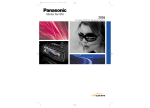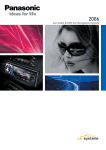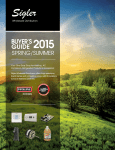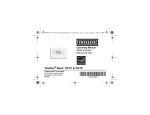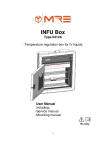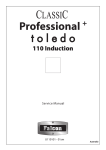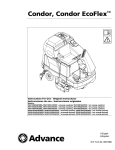Download Coil Cleaning - HVACpartners
Transcript
Target National Account Coil Maintenance and Cleaning Recommendations for Evaporator and Air--- Cooled Condenser Coils Aluminum -- Fin Coils, Copper/Copper Coils, Precoated Coils, E -- Coat Aluminum -- Fin Coils, E -- Coat Copper -- Fin Coils. Supplemental Service Manual NOTE: Read the entire Supplemental Service Manual before performing any maintenance and/or cleaning of unit coils. CAUTION is used to identify unsafe practices, which may result in minor personal injury or product and property damage. TABLE OF CONTENTS NOTE is used to highlight suggestions which will result in enhanced installation, reliability, or operation. SAFETY CONSIDERATIONS . . . . . . . . . . . . . . . . . . . . 1 PERIODIC CLEANING . . . . . . . . . . . . . . . . . . . . . . . . . 2 Remove Surface Loaded Fibers . . . . . . . . . . . . . . . . . . 2 Periodic Clean Water Rinse . . . . . . . . . . . . . . . . . . . . . 2 Cleaning of Coil Surfaces . . . . . . . . . . . . . . . . . . . . . . . 2 Totaline Environmentally-- Sound Coil Cleaner: Application Equipment . . . . . . . . . . . . . . . . . . . . . . . 2 Evaporator Coils . . . . . . . . . . . . . . . . . . . . . . . . . . . . 2 Periodic Cleaning of Air-- Cooled Condenser Coils . . 3 Cleaning of Heavily Contaminated Air-- Cooled Condenser Coils ONLY! . . . . . . . . . . . . . . . . . . . . . . 3 SAFETY CONSIDERATIONS Installation and servicing of air conditioning equipment can be hazardous due to system pressure and electrical components. Only trained and qualified service personnel should install, repair, or service air conditioning equipment. Untrained personnel can perform basic maintenance functions of cleaning coils and filters and replacing filters. Trained service personnel should perform all other operations. When working on air conditioning equipment,observe precautions in the literature, tags and labels attached to the unit,and other safety precautions that may apply. Follow all safety codes. It is important to recognize safety information. This is the . When you see this symbol on the safety-- alert symbol unit and in instructions or manuals, be alert to the potential for personal injury. Understand the signal words DANGER, WARNING, CAUTION, and NOTE. These words are used with the safety-- alert symbol. DANGER identifies the most serious hazards which will result in severe personal injury or death. WARNING signifies hazards which could result in personal injury or death. ! WARNING ELECTRICAL SHOCK HAZARD Failure to follow this warning could cause personal injury or death. Before performing service or maintenance operations on unit, always turn off main power switch to unit and install lock(s) and lockout tag(s). Unit may have more than one power switch. Ensure electrical service to rooftop unit agrees with voltage an amperage listed on the unit rating plate. ! CAUTION CUT HAZARD Failure to follow this caution may result in personal injury. Sheet metal parts may have sharp edges or burrs. Use care and wear appropriate protective clothing, safety glasses and gloves when handling parts and servicing air conditioning equipment. ! CAUTION PROPERTY DAMAGE HAZARD Failure to follow this caution may result in damage to roofing materials. Membrane roofs can be cut by sharp sheet metal edges. Be careful when placing any sheet metal parts on such roof. Inspect the unit interior and exterior at the beginning of each heating and cooling season and as operating conditions require. PERIODIC CLEANING ! Routine cleaning of coil surfaces is essential to maintain proper operation of the unit. Elimination of contamination and removal of harmful residues will greatly increase the life of the coil and extend the life of the unit. The following maintenance and cleaning procedures are recommended as part of the routine maintenance activities to extend the life of the coil. UNIT DAMAGE HAZARD Failure to follow this caution may result in corrosion and damage to the unit. Harsh chemicals, household bleach or acid or basic cleaners should not be used to clean outdoor or indoor coils or any kind. These cleaners can be very difficult to rinse out of the coil and can accelerate corrosion at the fin/tube interface where dissimilar materials are in contact. If there is dirt below the surface of the coil use the Totaline environmentally sound coil cleaner as described above. Coil Cleaning Remove Surface Loaded Fibers Surface loaded fibers or dirt should be removed with a vacuum cleaner. If a vacuum cleaner is not available, a soft nonmetallic bristle brush may be used. In either case, the tool should be applied in the direction of the fins .Coil surfaces can be easily damaged (fin edges bent over) if the tool is applied across the fins. ! NOTE: Use of a water stream, such as a garden hose, against a surface loaded coil will drive the fibers and dirt into the coil. This will make cleaning efforts more difficult. Surface loaded fibers must be completely removed prior to using low velocity clean water rinse. CAUTION UNIT RELIABILITY HAZARD Failure to follow this caution may result in reduced unit performance. High velocity water from a pressure washer, garden hose, or compressed air should never be used to clean a coil. The force of the water or air jet will bend the fin edges and increase airside pressure drop. Periodic Clean Water Rinse A periodic clean water rinse is very beneficial for coils that are applied in coastal or industrial environments. However, it is very important that the water rinse is made with very low velocity water stream to avoid damaging the fin edges. Monthly cleaning as described below is recommended. CAUTION Evaporator Coils: 1. Although Totaline Environmentally Sound Coil Cleaner is harmless to humans, animals, marine life, and the environment, proper eye protection, such as safety glasses, is recommended during mixing and application. 2. Dilute the concentrated Environmentally Sound Coil Cleaner directly from the original container with 8 parts potable, clean water. This is the same as a dilution of 1 pint cleaner concentrate per gallon of clean water. Mixing should be done in a 2 1/2 - gallon garden sprayer. 3. Remove filters from the unit. Remove any accessories that may hamper cleaning. Refer to unit or accessory installation instructions for removal of these items. 4. Remove all surface loaded fibers and dirt with a vacuum cleaner as described above. 5. Spray both sides of coil with the cleaning solution until completely saturated. 6. For best results, back flush toward the entering air side of the coil to remove any foreign material. Thoroughly rinse with clean potable water to remove residual cleaning agent and contamination. 7. Flush the condensate pan after completion. 8. Reinstall filters, accessories and access panels. Cleaning of Coil Surfaces Periodic cleaning with Totaline Environmentally Sound Coil Cleaner (1 gal., Totaline Pt. No. P902--0301) is essential to extend the life of coils. It is recommended that all evaporator and condenser coils, including standard aluminum, precoated, copper/copper, or E--Coat coils, are cleaned with the Totaline Environmentally Sound Coil Cleaner as described below. Coil cleaning should be part of the unit’s regularly scheduled maintenance procedures to ensure long life of the coil. Failure to clean the coils may result in reduced durability in the environment. Totaline Environmentally Sound Coil Cleaner agent will not harm the coil or surrounding components such as electrical wiring, painted metal surfaces, or insulation. Use of non--recommended coil cleaners is strongly discouraged since coil and unit durability could be affected. Totaline Environmentally-Sound Coil Cleaner: Application Equipment S 2 1/2 - gallon poly garden sprayer S Safety goggles S Clean potable water rinse with low velocity spray nozzle C13020 2 Periodic Cleaning of Air-- Cooled Condenser Coils: Fig. 2 - Rinsing Coil Cleaning Solution 12. The residuals in the resulting rinse water are not hazardous and will not harm surrounding plants, roofs, or nearby equipment. 13. Replace condenser fan/motor/grille assemblies, grilles, hoods, guards, or coil access panels. Cleaning of Heavily Contaminated Two-- Piece Air-- Cooled Condenser Coils ONLY! IMPORTANT: It is not necessary to separate two-- piece coils if they are cleaned on a periodic basis, however, if the coils are heavily contaminated use the following procedure to insure that all surfaces of the two-- piece coil are thoroughly cleaned. 1. Turn unit power off. 2. Clean area around the unit to ensure loose debris, such as leaves, will not be blown into the coil. 3. Remove security grilles, wind baffles, hail guards, or coil access panels. 4. Remove top panel screws on the condenser end of the unit. See Fig. 3 for location of screws to be removed. TOP PANEL Fig. 1 - Applying Coil Cleaner C13047 REMOVE SCREWS CONDENSER FAN CONTROL BOX CORNER POST C13021 9. Ensure all coil surfaces including finned area, tube sheets, and coil headers are saturated with the cleaning solution. Make sure cleaner thoroughly penetrates deep into finned areas. Interior and exterior finned areas must be thoroughly saturated for the cleaner to be effective. 10. Allow the cleaning solution to react with the coil contamination for 5 to 10 minutes. 11. Thoroughly rinse coil with low velocity clean water through the openings vacated by the condenser fan COIL CENTER POST REMOVE SCREWS CONDENSER COIL REMOVE COIL CORNER POST C13048 Fig. 3 - Location of Screws and Coil Corner Post 3 Coil Cleaning 1. Although Totaline Environmentally Sound Coil Cleaner is harmless to humans, animals, marine life, and the environment, proper eye protection, such as safety glasses, is recommended during mixing and application. 2. Turn unit power off. NOTE: Cleaning is most effective when condenser coil is warm from use. However, cool condenser coils can be cleaned effectively with the Environmentally Sound Coil Cleaner as described below. 3. Remove security grilles, wind baffles, hail guards, or coil access panels. 4. Clean area around the unit to ensure loose debris, such as leaves, will not be blown into the coil. 5. Remove all surface loaded fibers and dirt with a vacuum cleaner as described above. 6. To access the back side of the coils, remove condenser fan/motor/grille assembly by unfastening the screws securing the assembly to the top of the unit. Flip the assembly over and place it grill side down to rest on top of the unit. NOTE: Depending on the size of the unit there can be up to six condenser fan assemblies. Be sure to only remove the ones located closest to the condenser coils. 7. Dilute the concentrated Environmentally Sound Coil Cleaner directly with 4 parts clean potable water. This is the same as mixing 1 quart cleaner per gallon clean potable water. Mixing should be done in a 2 1/2- gallon garden sprayer. 8. Apply the coil cleaner by spraying the solution onto the outside of the coil. Hold the garden sprayer nozzle close to finned areas and apply cleaner with a vertical, up--and--down motion. Avoid spraying in horizontal pattern to minimize potential for fin damage. assemblies. Using downward rinsing motion of water spray nozzle as shown in Fig. 2. Protect fins from damage from the spray nozzle. 5. Remove condenser coil corner post (see Fig. 3). To hold top panel open, place coil corner post between top panel and center post (see Fig. 4). COIL CORNER POST CENTER BAFFLE TOP PANEL Coil Cleaning CONDENSER COIL C13049 Fig. 4 - Propping Up Top Panel 6. Remove screws securing coil to center post. 7. To access the back side of the coils, remove condenser fan/motor/grille assembly by unfastening the screws securing the assembly to the top of the unit. Flip the assembly over and place it grill side down to rest on top of the unit. NOTE: Depending on the size of the unit there can be up to six condenser fan assemblies. Be sure to only remove the ones located closest to the condenser coils. 8. Remove clips securing tube sheets together at the return bend end of the coil. Carefully separate the outer coil section 3 to 4 inches from the inner coil section. See Fig. 5. TOP VIEW TOP PANEL CONDENSER COIL INNER COIL SECTION 9. Remove all surface loaded fibers and dirt with a vacuum cleaner as described above. Ensure surfaces between the sections are thoroughly vacuumed. 10. Although Totaline Environmentally Sound Coil Cleaner is harmless to humans, animals, marine life, and the environment, proper eye protection, such as safety glasses, is recommended during mixing and application. NOTE: Cleaning is most effective when condenser coil is warm from use. However, cool condenser coils can be cleaned effectively with the Environmentally Sound Coil Cleaner as described below. 11. Dilute the concentrated Environmentally Sound Coil Cleaner directly with 4 parts clean potable water. This is the same as mixing 1 quart cleaner per gallon clean potable water. Mixing should be done in a 2 1/2- gallon garden sprayer. 12. Hold the garden sprayer nozzle close to finned areas and apply cleaner with a vertical, up-- and-- down motion. Avoid spraying in horizontal pattern to minimize potential for fin damage. 13. Ensure all coil surfaces including finned area, tube sheets, and coil headers are saturated with the cleaning solution. Make sure cleaner thoroughly penetrates deep into finned areas. Interior and exterior finned areas must be thoroughly saturated for the cleaner to be effective. 14. Allow the cleaning solution to react with the coil contamination for 5 to 10 minutes. 15. Thoroughly rinse coil with low velocity clean water through the openings vacated by the condenser fan assemblies. Using downward rinsing motion of water spray nozzle as shown in Fig. 2. Protect fins from damage from the spray nozzle. 16. The residuals in the resulting rinse water are not hazardous and will not harm surrounding plants, roofs, or nearby equipment. 17. Reposition outer coil sections. 18. Reinstall clips that secure tube sheets. 19. Replace top cover and corner post. 20. Replace condenser fan/motor/grille assemblies, grilles, hoods, guards, or coil access panels. CENTER BAFFLE 4” MAX RETURN END OUTER COIL SECTION Fig. 5 - Separating Coil Sections Copyright 2013 Carrier Corp. D 7310 W. Morris St. D Indianapolis, IN 46231 C13050 Edition Date: 01/13 Manufacturer reserves the right to change, at any time, specifications and designs without notice and without obligations. 4 Catalog No: TAR ---01SM Replaces: New





